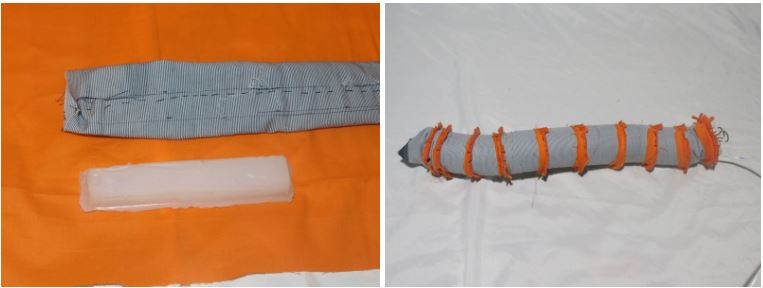The sleeve gives the robot structure and is created by sewing a tube out of an inextensible cotton fabric. It is connected to the front and back ends of the bladders with zip ties. When the bladders are not inflated, the sleeve is compressed longitudinally (similar to pushing up the sleeve of a long sleeve shirt). As the bladder inflates, it expands, filling the sleeve. In this project all of the sleeves are designed for extension.
In most soft robots, a single puncture in one of the bladders indicates the entire robot would need to be replaced. However, in the fabric-reinforced actuator, a punctured bladder can be easily removed and replaced in a few minutes with no special equipment required. This makes the robot not only completely soft but also repairable in the field.

The first sleeve prototype was a single cavity sleeve. It was made from a single piece of fabric that was curled into a tube. This meant that the sleeve needed to be sewn by hand because a sewing machine would have sewn through both sides of the tube. Functionally, this sleeve had a tendency to roll sideways when inflated and had no turning capabilities. However, it did work well enough to test the fabric-reinforced actuator concept. Once the concept was proven viable, it was used to test the various foot prototypes.

The second sleeve prototype was designed with two side by side bladder compartments separated by one half inch of fabric. It was made from two pieces of fabric that were sewn together using a sewing machine. This method made it easier to produce multi bladder sleeves. Additional compartments could be made by sewing more lines into the fabric. Functionally, the wider sleeve was more stable than the first prototype. Additionally, the arrangement of the two bladders made it possible to turn left or right by inflating one side of the sleeve at a time. However, it was unable to bend up (a movement necessary for climbing). This sleeve was used to test and determine foot placement.

The final sleeve prototype added a third bladder compartment sewn on to the top of the previous prototype design. This gave the robot the ability to bend up and down in addition to left and right. The top compartment is only attached to the rest of the robot at both ends and roughly an inch in the middle of the sleeve. This allowed the robot to bend upwards at a corner rather than a curve and made it easier to climb over objects. This sleeve was used in the final design.
The folds in the compressed sleeve highlight a potential design weakness. These ripples are more likely to get caught on objects than the smooth rubber wall. Different sleeve materials can be chosen to minimize snagging.
